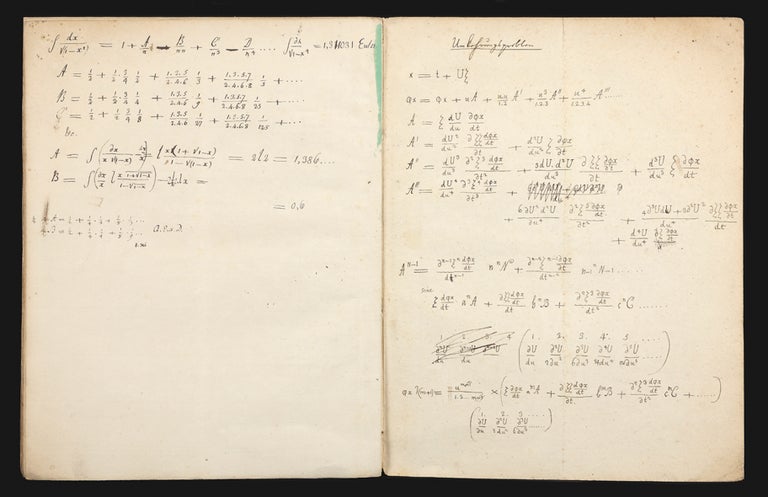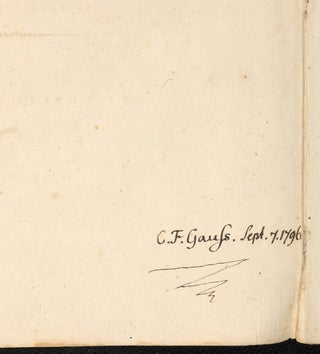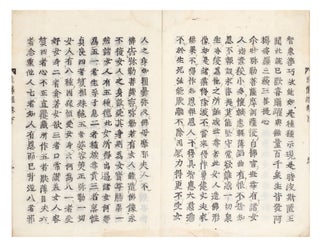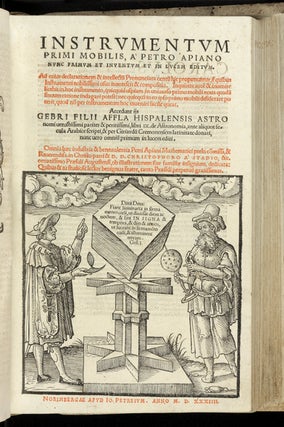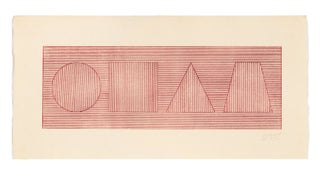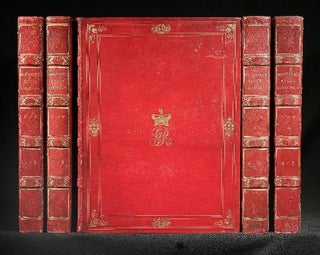With Extensive Autograph Exercises & Corrections by Gauss
Usus Logarithmorum Infinitomii in Theoria aequationum.
One folding printed table. 1 p.l., 46 pp., one leaf of errata. Large 4to, orig. semi-stiff drab boards (extremities a bit rubbed). Leipzig: C.T. Rabenhorst, 1796.
A remarkable discovery: this is essentially a workbook of the young and precocious Carl Friedrich Gauss, signed and dated by him “C. F. Gauss Sept. 7, 1796” on the inner front cover, at which time he was a 19-year old student in Göttingen. Gauss has not only studied the text carefully, making several corrections to the text, but has also made use of two blank pages at the end to carry out exercises (described in detail below). Mathematical manuscripts of Gauss are of the greatest rarity on the market, especially from his early formative years.
Moritz von Prasse (1769-1814), was the son of Johann Moritz Prasse, who worked as a mediator in the Seven Years’ War at the Court of Catherine the Great in St. Petersburg (and according to some sources may have been her lover). His service led to his family’s elevation to the nobility on 31 July 1790. Prasse studied mathematics at the University of Leipzig, graduating in 1795, and rising to become professor there in 1799. He became a member of the Jablonowski Society in 1807 and maintained a correspondence on mathematical topics with Goethe. The great geometer August Ferdinand Möbius was among his students. Apart from the present work, his first, he also published De Reticules Cryptographicis (1799), a method of encrypting messages using rotating dials, and a set of Logarithmischen Tafeln in 1810. His extensive library of works on mathematics was bequeathed to his university on his death in 1814.
The present work by Prasse is concerned with the “polynomial theorem,” a generalization of the binomial theorem: whereas the binomial theorem gives a series expansion for powers of the sum of two terms, the polynomial theorem treats the sum of any finite (or even an infinite) number of terms. The formula was first proved by Carl Hindenburg (1741-1808), the founder of the modern theory of combinatorics. It has been known at least since the work of Pascal that the coefficients in the binomial expansion can be interpreted as numbers of combinations, and Hindenburg showed that the coefficients occurring in the polynomial theorem also had a combinatorial interpretation. He believed that this result could be used to provide a combinatorial basis for the whole of the theory of functions, and gathered around him a group of disciples, which became known as the “Combinatorial School,” to develop and propagate this idea. This School included Prasse, as well as Johann Friedrich Pfaff, who became Gauss’s teacher after he moved to Helmstedt in 1798. Although the Combinatorial School did not produce the significant advances Hindenburg had hoped for, it “was influential in Germany at the turn of the 19th century and became the basis of the mathematical syllabus of the Prussian gymnasium in the Humboldt educational system.”–Jahnke, p. 265 (see below for citation). In this atmosphere it would have been natural for the young Gauss to have been required to study Prasse’s work, one of the most recently published products of the Combinatorial School.
Both of the exercises worked out by Gauss deal, like Prasse’s work, with series expansions. The first exercise develops a series expansion of the indefinite integral of (1 – xn)-½ over the interval from 0 to 1, in increasing powers of 1/n (Gauss does not specify the range of integration but this is evident from the context). Gauss writes down the answer without explanation, presumably because the intermediate steps were so straightforward for him that he was able to carry them out mentally. His answer can be obtained by first expanding (1 – xn)-½ in increasing powers of xn and then integrating term by term. This yields terms involving 1/n + 1, 1/2n + 1, etc, which are then expanded in increasing powers of 1/n using the binomial theorem. Collecting powers of 1/n gives Gauss’s series expansion of the integral. The coefficients of the powers of 1/n in this expansion are themselves infinite series, which Gauss sums by cleverly expressing them as definite integrals, which he then evaluates directly (again Gauss gives no explanation or working, but the integrals can be evaluated by standard methods with which Gauss was obviously very familiar).
In the second exercise Gauss obtains a series expansion of ϕ(t + U), where U is a function of another variable u, in increasing powers of u. This can be done using Taylor’s theorem, although this is not quite straightforward as the derivatives of ϕ(t + U) with respect to u have to be evaluated using the chain rule. Again it is evident that the exercise was nevertheless a simple matter for Gauss as the (correct) answer is written down without explanation or any intermediate steps (although there is one correction!). In fact, Gauss is actually treating a multi-variable case: the presence of multiple Σs indicates that he is treating a case in which ϕ is a function of several variables x1, x2,...,xn, but this does not cause him any difficulty.
Gauss has also made, as mentioned above, corrections on the following pages: 1, 3, 4, 8, 9, 11, 13, 14, 16, 20, and 21.
Fine and fresh condition. Preserved in a handsome black morocco-backed box. With the stamps of the “Gauss-Bibliothek” and the Royal Observatory at Göttingen on title with release stamp date 15 October 1951 on facing endpaper.
❧ Poggendorff II, 518. Tomash Library P108. See H. N. Jahnke, “Algebraic Analysis in Germany 1780-1840” in Historia Mathematica 20, pp. 265-284 for a detailed account of the work of the Combinatorial School.
Price: $65,000.00
Item ID: 3374

